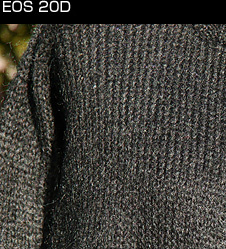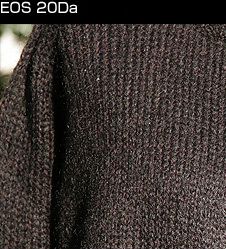The Canon EOS 20Da is almost identical to the existing model, but with a couple of hardware and firmware tweaks to make the camera better suited to astrophotography. Most importantly, the infrared cutoff filter from the EOS 20D has been replaced with a less aggressive filter that allows approximately 2.5x as much light in H-alpha wavelengths to pass. This new filter allows for improved astrophotography, but does come with a drawback (as demonstrated in the following comparison images from Canon Japan's website) - when using the EOS 20Da for regular photography, subjects with a lot of reflected infrared light will exhibit a red tint:


In the photos above, cropped from larger images of a Japanese model, you can see that the regular EOS 20D renders the model's black cardigan correctly - but the EOS 20Da gives the cardigan a distinct red tint. The problem isn't insurmountable - you can purchase infrared cutoff filters that are mounted on the front of your lenses. That solution will likely necessitate several filters to accommodate the differing lens thread sizes of your various lenses, however, and the filters can be very expensive (particularly in the largest sizes). Something to be aware of if you're considering purchasing a 20Da, and using it for regular photography as well as astrophotography.
A second new feature allows a live preview image to be seen on the EOS 20Da's LCD display, making the 20Da the second camera we're aware of to offer a live preview - the first being Fujifilm's FinePix S3 Pro. As with Fujifilm's camera though, the live preview is not what many users will be hoping for. We regularly hear from readers wishing to have a live preview on their digital SLRs, much the same as they have experienced on other digital cameras. There's little question that if offered, the feature would be of some benefit to users in certain situations. If an SLR were to have a tilt / swivel LCD screen, for example, you could cover the optical viewfinder to prevent stray light entering the optical path, and then hold the camera away from your face - perhaps shooting images from the waist or above your head, to capture images you otherwise might not have been able to manage (at least, not with the ability to carefully compose and frame them). A live preview on an SLR might also offer the ability to have such things as live histograms, or live indication of under- and over-exposure, allowing the user to tweak their exposure accordingly without taking a test photo first. Finally (and perhaps of the least actual benefit), there's the potential to add features like movie clips to an SLR.
While the EOS 20Da's live preview does confirm once and for all the longstanding rumor that Canon's CMOS sensors were capable of such a feature, it does not bring any of these hoped-for advantages to the market. Instead, it is aimed very clearly at use in an astrophotography setting, and would be of little benefit beyond that function. In Fujifilm's S3 Pro, the live preview was of limited use thanks to the fact that it was black and white only, offered only 30 seconds of preview time, and gave no way to shoot an image while the preview was functioning. The EOS 20Da likewise has a strict limitation that hints towards the technical challenges of offering a live preview in a digital SLR. Specifically, when the camera's preview is functioning, the mirror is locked up (we've seen reference to a partially transmissive mirror elsewhere, but the regular EOS 20D features the same 40:60 partially transmissive mirror as the new 20Da). The mirror being locked up means that light can arrive at the image sensor, but it also means that the camera's autofocus and metering sensors (which rely on the camera's mirrors to receive some of the light from the optical path) are now unuseable. Hence exposure and focus must be set completely manually - something that would dissuade most users from trying to use the 20Da to grab candid photos in such a manner. Also, the live preview mode seems to enlarge the preview image, helpful in determining focus for an astrophotography image, but not if you're trying to frame a candid image above a crowd of people. Nor does the camera have a tilt-swivel LCD - and if you can see the LCD straight-on, you'd be able to use the optical viewfinder anyway.
As we understand it from browsing Canon Japan's website, to use the live preview feature on the EOS 20Da, you must first set the camera to 'M' (Manual) mode, set the camera to bulb mode, and then roll the main dial to select either 'FC1' or 'FC2' mode (the difference apparently being the amount of magnification of the LCD image - either 5x or 10x. You then set your lens to 'MF' (manual focus), press your shutter button (or use your remote control), and the live preview appears. At this point, you set your aperture with the main dial, and ISO sensitivity with the quick control dial. Then you press the shutter button again, adjust your focus manually, and set the shutter speed with the main dial, before finally capturing the image. Canon's website also notes that the live preview function is not compatible with the following lenses, thanks to their use of electronic manual focusing systems:
- EF300mm F2.8L USM
- EF50mm F1.0L USM
- EF28-80mm F2.8-4L USM
- EF1200mm F5.6L USM
- EF200mm F1.8L USM
- EF600mm F4L USM
- EF85mm F1.2L USM
- EF400mm F2.8L USM
- EF500mm F4.5L USM
- EF400mm F2.8LII USM
We'd be surprised if a manufacturer doesn't come up with a way to offer a more "multipurpose" live LCD preview on a digital SLR with a tilt / swivel LCD eventually; there is certainly a good deal of demand for such a feature, and even the naysayers might find themselves using it occasionally were it available. The 20Da is not that camera though, and the manufacturer will have to come up with alternatives for focusing and exposure (perhaps using the imager to perform these functions when the mirror is raised, or capturing the image through a partially transmissive mirror - with an attendant loss in light gathering and shutter speed). Other potential stumbling blocks such as dust reaching the sensor from in front of the mirror, as well as battery life and sensor temperature issues associated with running the imager for extended periods of time are already the case in long exposures anyway; focusing and exposure look to be the main issues.
One further point for the EOS 20Da which we're not certain is a new feature relates to noise levels at high ISO sensitivity. Canon Japan's pages on the camera specifically mention noise performance, and a "second generation" noise reduction system - but this may just be referring to the same feature as found in the original EOS 20D, itself a big step forward from Canon's previous EOS 10D model.
No decision has yet been taken to sell the Canon EOS 20Da outside Japan. We'll be surprised if the company doesn't receive numerous requests from astrophotographers in other countries looking to obtain the camera, however, as it looks ideally suited for astrophotographers thanks to the 20D's already excellent high-ISO performance and the new features described above. Pricing and availability for the EOS 20Da in Japan are not yet available; as we understand it from our good friend Yamada Kumio of the Japanese digitalcamera.jp website, the camera will be available for preorder from tomorrow, and payment will be required in around three months time, suggesting the camera will ship around the middle of this year.